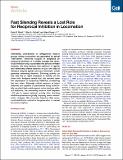Files in this item
Fast silencing reveals a lost role for reciprocal inhibition in locomotion
Item metadata
| dc.contributor.author | Moult, Peter Robert | |
| dc.contributor.author | Cottrell, Glen Alfred | |
| dc.contributor.author | Li, Wenchang | |
| dc.date.accessioned | 2013-02-18T10:01:01Z | |
| dc.date.available | 2013-02-18T10:01:01Z | |
| dc.date.issued | 2013-01-09 | |
| dc.identifier | 42943976 | |
| dc.identifier | 1a13399b-f58a-4958-8212-53e068b72511 | |
| dc.identifier | 84872180961 | |
| dc.identifier | 000313404600013 | |
| dc.identifier.citation | Moult , P R , Cottrell , G A & Li , W 2013 , ' Fast silencing reveals a lost role for reciprocal inhibition in locomotion ' , Neuron , vol. 77 , no. 1 , pp. 129-140 . https://doi.org/10.1016/j.neuron.2012.10.040 | en |
| dc.identifier.issn | 0896-6273 | |
| dc.identifier.other | ORCID: /0000-0002-1179-6636/work/64361136 | |
| dc.identifier.uri | https://hdl.handle.net/10023/3357 | |
| dc.description.abstract | Summary Alternating contractions of antagonistic muscle groups during locomotion are generated by spinal “half-center” networks coupled in antiphase by reciprocal inhibition. It is widely thought that reciprocal inhibition only coordinates the activity of these muscles. We have devised two methods to rapidly and selectively silence neurons on just one side of Xenopus tadpole spinal cord and hindbrain, which generate swimming rhythms. Silencing activity on one side led to rapid cessation of activity on the other side. Analyses reveal that this resulted from the depression of reciprocal inhibition connecting the two sides. Although critical neurons in intact tadpoles are capable of pacemaker firing individually, an effect that could support motor rhythms without inhibition, the swimming network itself requires ∼23 min to regain rhythmic activity after blocking inhibition pharmacologically, implying some homeostatic changes. We conclude therefore that reciprocal inhibition is critical for the generation of normal locomotor rhythm. | |
| dc.format.extent | 12 | |
| dc.format.extent | 1676795 | |
| dc.language.iso | eng | |
| dc.relation.ispartof | Neuron | en |
| dc.subject | RC0321 Neuroscience. Biological psychiatry. Neuropsychiatry | en |
| dc.subject.lcc | RC0321 | en |
| dc.title | Fast silencing reveals a lost role for reciprocal inhibition in locomotion | en |
| dc.type | Journal article | en |
| dc.contributor.sponsor | The Wellcome Trust | en |
| dc.contributor.institution | University of St Andrews. School of Psychology and Neuroscience | en |
| dc.contributor.institution | University of St Andrews. Institute of Behavioural and Neural Sciences | en |
| dc.contributor.institution | University of St Andrews. School of Biology | en |
| dc.identifier.doi | https://doi.org/10.1016/j.neuron.2012.10.040 | |
| dc.description.status | Peer reviewed | en |
| dc.identifier.url | http://europepmc.org/articles/PMC3542422 | en |
| dc.identifier.grantnumber | 089319/Z/09/Z | en |
This item appears in the following Collection(s)
Items in the St Andrews Research Repository are protected by copyright, with all rights reserved, unless otherwise indicated.

